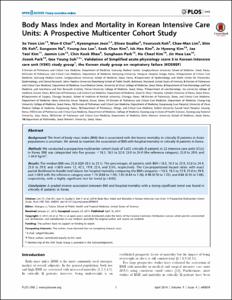KUMEL Repository
1. Journal Papers (연구논문)
1. School of Medicine (의과대학)
Dept. of Internal Medicine (내과학)
Body Mass Index and Mortality in Korean Intensive Care Units: A Prospective Multicenter Cohort Study
- Keimyung Author(s)
- Choi, Won Il
- Department
- Dept. of Internal Medicine (내과학)
- Journal Title
- PLoS One
- Issued Date
- 2014
- Volume
- 9
- Issue
- 4
- Abstract
- Background
The level of body mass index (BMI) that is associated with the lowest mortality in critically ill patients in Asian populations is uncertain. We aimed to examine the association of BMI with hospital mortality in critically ill patients in Korea.
Methods
We conducted a prospective multicenter cohort study of 3,655 critically ill patients in 22 intensive care units (ICUs) in Korea. BMI was categorized into five groups: <18.5, 18.5 to 22.9, 23.0 to 24.9 (the reference category), 25.0 to 29.9, and ≥30.0 kg/m2.
Results
The median BMI was 22.6 (IQR 20.3 to 25.1). The percentages of patients with BMI<18.5, 18.5 to 22.9, 23.0 to 24.9, 25.0 to 29.9, and ≥30.0 were 12, 42.3, 19.9, 22.4, and 3.3%, respectively. The Cox-proportional hazard ratios with exact partial likelihood to handle tied failures for hospital mortality comparing the BMI categories <18.5, 18.5 to 22.9, 25.0 to 29.9, and ≥30.0 with the reference category were 1.13 (0.88 to 1.44), 1.03 (0.84 to 1.26), 0.96 (0.76 to 1.22), and 0.68 (0.43 to 1.08), respectively, with a highly significant test for trend (p = 0.02).
Conclusions
A graded inverse association between BMI and hospital mortality with a strong significant trend was found in critically ill patients in Korea.
- Keimyung Author(s)(Kor)
- 최원일
- Publisher
- School of Medicine
- Citation
- So Yeon Lim et al. (2014). Body Mass Index and Mortality in Korean Intensive Care Units: A Prospective Multicenter Cohort Study. PLoS One, 9(4), e90039–e90039. doi: 10.1371/journal.pone.0090039
- Type
- Article
- ISSN
- 1932-6203
- Appears in Collections:
- 1. School of Medicine (의과대학) > Dept. of Internal Medicine (내과학)
- 파일 목록
-
-
Download
 oak-aaa-04195.pdf
기타 데이터 / 258.35 kB / Adobe PDF
oak-aaa-04195.pdf
기타 데이터 / 258.35 kB / Adobe PDF
-
Items in Repository are protected by copyright, with all rights reserved, unless otherwise indicated.